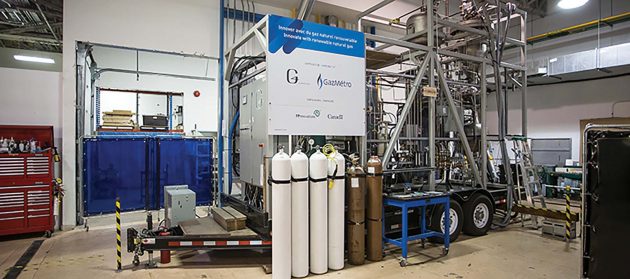
Green power: a battery breakthrough and wood-to-gas
By PLANT Staff
Industry Sustainability Energy Manufacturing Resource Sector battery biofuel biomass Gaz Metro natural gas University of WaterlooUniversity of Waterloo and Gaz Metro provide alternatives to traditional energy sources.

Gaz Metro’s pilot project uses a thermochemical process to turn forest biomass into natural gas. PHOTO: GAZ METRO
There have been a couple of interesting developments in the quest for cleaner forms of energy. Chemists at the University of Waterloo have developed a long-lasting zinc-ion battery that costs half the price of lithium-ion batteries and aid in the shift away from traditional power plants to solar and wind energy production. In Quebec, Gaz Metro, working with G4 Insights, is piloting a wood-to-gas conversion process that provides a natural alternative to the fossil variety of fuel.
First the battery and the science behind it. The University of Waterloo reports the zinc-ion version uses non-flammable, non-toxic materials and a pH-neutral, water-based salt. A water-based electrolyte, pillared vanadium oxide positive electrode and ametallic zinc negative electrode combine to generate electricity through a reversible process called intercalation.
The process involves positively charged zinc ions that are oxidized from the zinc metal negative electrode. They travel through the electrolyte and insert between the layers of vanadium oxide nanosheets in the positive electrode. This drives electrons in the external circuit to create an electrical current. The reverse process occurs on charge.
The cell is the first demonstration of zinc ion intercalation in a solidstate material that satisfies high reversibility, rate and capacity with no zinc dendrite formation. It delivers more than 1,000 cycles with 80% capacity retention and energy density of 450 watt-hours per litre. Lithium-ion batteries also operate by intercalation, but they typically use expensive, flammable, organic electrolytes.
The global energy storage market is expected to grow to $25 billion in the next 10 years. Manufacturers can produce the Waterloo zinc battery at low cost because fabrication doesn’t require special conditions, such as ultra-low humidity or the handling of flammable materials needed for lithium ion batteries.
Water in the electrolyte facilitates the movement of zinc ions and swells the space between the sheets, like tiers of a wedding cake. This gives the zinc enough room to enter and leave the positive structure as the battery cycles. The electrode material’s nano-scale dimensions and the battery’s high-conductivity aqueous electrolyte also improve cycling life and response times.
The Waterloo team is working with researchers at the Joint Center for Energy Storage Research in Washington, DC to investigate multivalent ion intercalation batteries based on Mg2+ in non-aqueous electrolytes. They were the first to report highly reversible Mg cycling in the TiS2 thiospinel and layered sulfides, which represent the first new highly functional Mg insertion materials announced in more than 15 years.
Pilot project complete
And now the more natural “natural gas.” Energy distributor Gaz Metro has successfully completed a pilot project that converts wood chips into natural gas using a thermochemical process.
The project has been running for several months in collaboration with Burnaby, BC-based cleantech company G4 Insights, and deploys a thermochemical or heat-induced process known as PyroCatalytic Hydrogenation (PCH) to convert forest industry biomass to natural gas.
While much of Quebec’s energy, particularly electricity, already comes from clean sources, higher-emissions industries – including transportation – would benefit from the development of cleaner sources of natural gas. Fossil-based natural gas is typically produced alongside oil or from shale and used in a variety of applications, including compressed or liquefied natural gas vehicles, power generation and heating.
Governments worldwide are committing to reducing CO2 emissions, making natural gas a “bridge fuel” as economies transition from traditional energy to renewable and cleaner sources.
Gaz Metro’s first-of-its-kind demonstration project was run at the company’s Natural Gas Technologies Centre in Boucherville, Que.
Saint-Hyacinthe was the first city in Quebec to produce energy through biomethanation and move closer to energy independence. Partnering with Gaz Metro, the city will heat municipal buildings and fuel city vehicles. This project will eventually lead to an annual reduction of 25,000 tonnes of greenhouse gas.
G4 develops renewable energy technologies, including a pyrocatalytique hydrogenation technology for renewable natural gas production. Its system uses a pyrolysis process and proprietary thermochemical catalyst that converts forest biomass into renewable natural gas.
Gaz Metro is moving forward. The technology is ready to be tested as part of a larger pilot that will produce higher volumes of renewable fuel.
